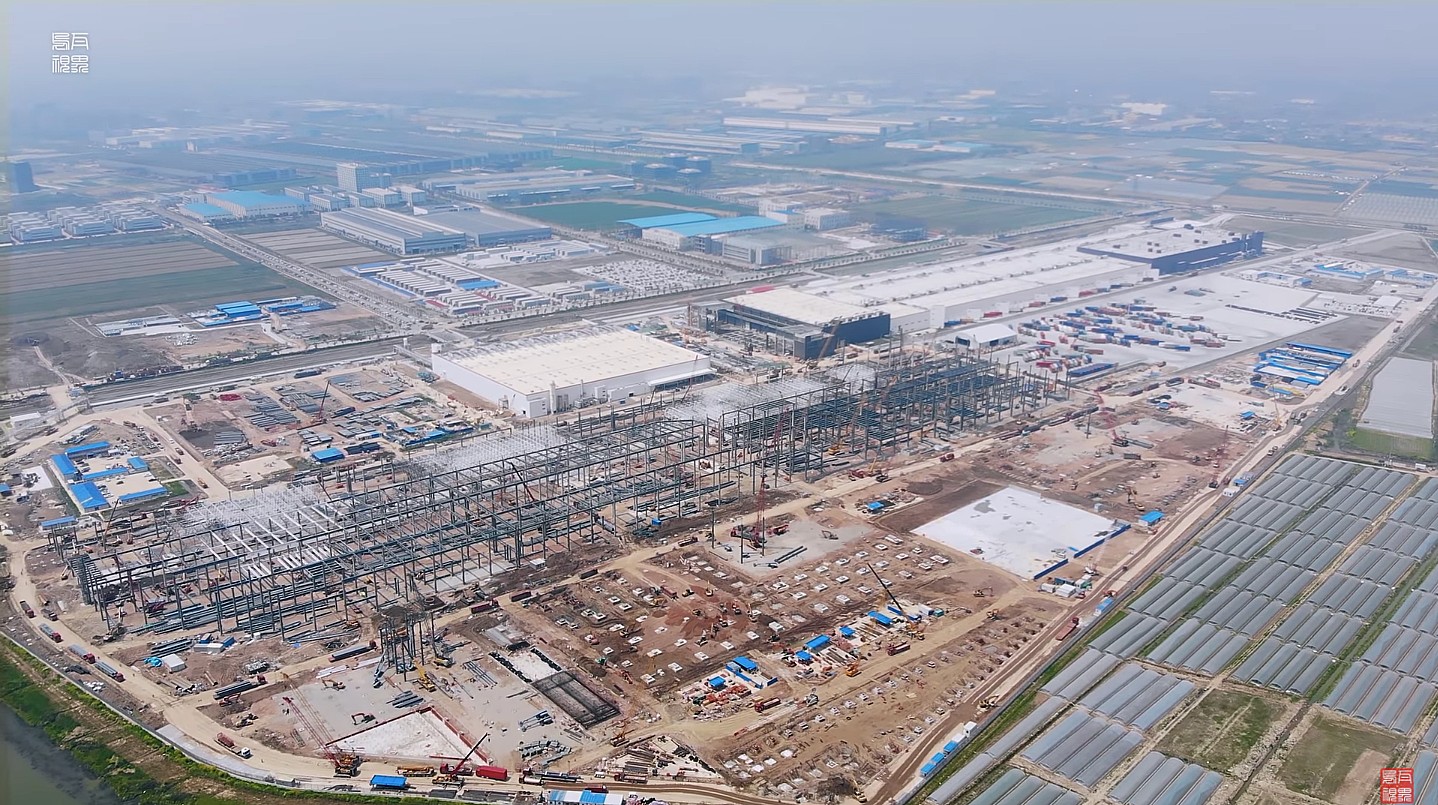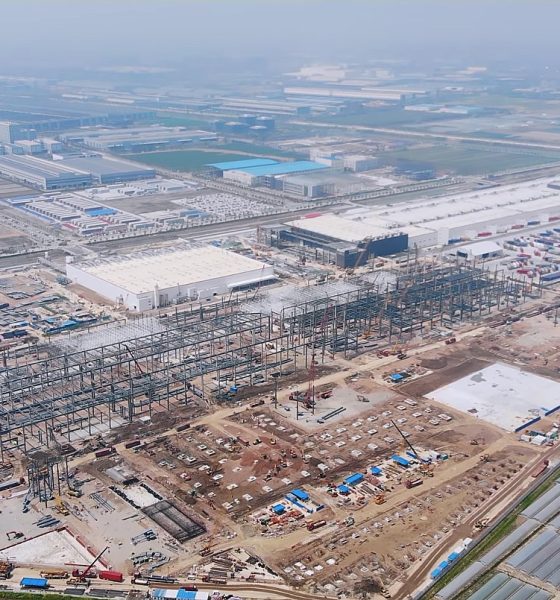

News
Tesla China VP talks Shanghai factory, Model Y and adapting to a COVID-19 world
Tesla China’s Vice President of Foreign Affairs Grace Tao gave an extensive update to Giga Shanghai’s production rate, Phase 2 progress, and how the company has evolved in a pandemic-affected work environment.
In an interview with Chinese media outlet Xinhuanet, Tao described Giga Shanghai’s projected production rate for June, along with the introduction of the Model Y in China.
Tao stated Giga Shanghai operation is going smoothly and may reach a 4,000 vehicle per week production rate as early as June. The figure of 4,000 Model 3s being rolled off production lines in Shanghai will help the company reach its anticipated annual production rate of 200,000 electric cars a year, exceeding its prior expectations of 150,000 units annually or around 3,000 Model 3s a week. In contrast, only the first phase of the Chinese production facility is built.
Giga Shanghai’s Phase 2 is also coming along nicely, Tao said. The company fully anticipates the completion of Phase 2 by the end of the year, which means the Model Y could begin mass production as early as Q1 2021.
The sheer size of Phase 2 and Tesla’s construction speed is impressive. The company completed the first phase of Giga Shanghai in one year, as the company announced public Model 3 deliveries and the Model Y manufacturing project on January 7, 2020. This date in 2019 is the exact day construction started in Shanghai.
The company has also been forced to adapt to a new world that is dealing with the massive COVID-19 pandemic. Considering the virus has origins in the Asian country, Giga Shanghai would have been a prime candidate for an extended shutdown. However, the facility was only closed for around a week and reopened on February 10. An extended playbook that described safety and health procedures for employees at Giga Shanghai has been increasingly effective in keeping workers safe and production rates steady.
The “Chinese Operation Manual” details how people can remain safe amidst the pandemic, and was the basis for Tesla’s “Return to Work Playbook” that was written to describe safe procedures for the Fremont factory’s reopening.
Outside of the factory, Tesla stores have adapted to the new process of showing the company’s products to prospective owners. Tao stated that Tesla’s internet site had become a mainstay in keeping the company’s sales healthy. At the same time, in-store experiences are crucial for introducing new product experiences and showing new features with the company’s cars.
For example, Tesla just released its White Model 3 interior in China. While virtually anyone with an internet connection can see what it looks like, the stores allow interested buyers in seeing the interior color in person, determining whether the option is right for them.
Tao stated that Tesla plans to expand its stores, which she refers to as “experience centers,” into new territories “based on the expansion of customer bases in different cities.”
Despite the overwhelming infection of COVID-19 in China, Tesla has adapted and established itself as an outlier in a failing automotive sector. The company just reduced the price of its base Model 3 to qualify for government incentives, making the vehicle even more affordable in an already strong market.

News
Nvidia CEO Jensen Huang explains difference between Tesla FSD and Alpamayo
“Tesla’s FSD stack is completely world-class,” the Nvidia CEO said.

NVIDIA CEO Jensen Huang has offered high praise for Tesla’s Full Self-Driving (FSD) system during a Q&A at CES 2026, calling it “world-class” and “state-of-the-art” in design, training, and performance.
More importantly, he also shared some insights about the key differences between FSD and Nvidia’s recently announced Alpamayo system.
Jensen Huang’s praise for Tesla FSD
Nvidia made headlines at CES following its announcement of Alpamayo, which uses artificial intelligence to accelerate the development of autonomous driving solutions. Due to its focus on AI, many started speculating that Alpamayo would be a direct rival to FSD. This was somewhat addressed by Elon Musk, who predicted that “they will find that it’s easy to get to 99% and then super hard to solve the long tail of the distribution.”
During his Q&A, Nvidia CEO Jensen Huang was asked about the difference between FSD and Alpamayo. His response was extensive:
“Tesla’s FSD stack is completely world-class. They’ve been working on it for quite some time. It’s world-class not only in the number of miles it’s accumulated, but in the way it’s designed, the way they do training, data collection, curation, synthetic data generation, and all of their simulation technologies.
“Of course, the latest generation is end-to-end Full Self-Driving—meaning it’s one large model trained end to end. And so… Elon’s AD system is, in every way, 100% state-of-the-art. I’m really quite impressed by the technology. I have it, and I drive it in our house, and it works incredibly well,” the Nvidia CEO said.
Nvidia’s platform approach vs Tesla’s integration
Huang also stated that Nvidia’s Alpamayo system was built around a fundamentally different philosophy from Tesla’s. Rather than developing self-driving cars itself, Nvidia supplies the full autonomous technology stack for other companies to use.
“Nvidia doesn’t build self-driving cars. We build the full stack so others can,” Huang said, explaining that Nvidia provides separate systems for training, simulation, and in-vehicle computing, all supported by shared software.
He added that customers can adopt as much or as little of the platform as they need, noting that Nvidia works across the industry, including with Tesla on training systems and companies like Waymo, XPeng, and Nuro on vehicle computing.
“So our system is really quite pervasive because we’re a technology platform provider. That’s the primary difference. There’s no question in our mind that, of the billion cars on the road today, in another 10 years’ time, hundreds of millions of them will have great autonomous capability. This is likely one of the largest, fastest-growing technology industries over the next decade.”
He also emphasized Nvidia’s open approach, saying the company open-sources its models and helps partners train their own systems. “We’re not a self-driving car company. We’re enabling the autonomous industry,” Huang said.
Elon Musk
Elon Musk confirms xAI’s purchase of five 380 MW natural gas turbines
The deal, which was confirmed by Musk on X, highlights xAI’s effort to aggressively scale its operations.

xAI, Elon Musk’s artificial intelligence startup, has purchased five additional 380 MW natural gas turbines from South Korea’s Doosan Enerbility to power its growing supercomputer clusters.
The deal, which was confirmed by Musk on X, highlights xAI’s effort to aggressively scale its operations.
xAI’s turbine deal details
News of xAI’s new turbines was shared on social media platform X, with user @SemiAnalysis_ stating that the turbines were produced by South Korea’s Doosan Enerbility. As noted in an Asian Business Daily report, Doosan Enerbility announced last October that it signed a contract to supply two 380 MW gas turbines for a major U.S. tech company. Doosan later noted in December that it secured an order for three more 380 MW gas turbines.
As per the X user, the gas turbines would power an additional 600,000+ GB200 NVL72 equivalent size cluster. This should make xAI’s facilities among the largest in the world. In a reply, Elon Musk confirmed that xAI did purchase the turbines. “True,” Musk wrote in a post on X.
xAI’s ambitions
Recent reports have indicated that xAI closed an upsized $20 billion Series E funding round, exceeding the initial $15 billion target to fuel rapid infrastructure scaling and AI product development. The funding, as per the AI startup, “will accelerate our world-leading infrastructure buildout, enable the rapid development and deployment of transformative AI products.”
The company also teased the rollout of its upcoming frontier AI model. “Looking ahead, Grok 5 is currently in training, and we are focused on launching innovative new consumer and enterprise products that harness the power of Grok, Colossus, and 𝕏 to transform how we live, work, and play,” xAI wrote in a post on its website.
Elon Musk
Elon Musk’s xAI closes upsized $20B Series E funding round
xAI announced the investment round in a post on its official website.

xAI has closed an upsized $20 billion Series E funding round, exceeding the initial $15 billion target to fuel rapid infrastructure scaling and AI product development.
xAI announced the investment round in a post on its official website.
A $20 billion Series E round
As noted by the artificial intelligence startup in its post, the Series E funding round attracted a diverse group of investors, including Valor Equity Partners, Stepstone Group, Fidelity Management & Research Company, Qatar Investment Authority, MGX, and Baron Capital Group, among others.
Strategic partners NVIDIA and Cisco Investments also continued support for building the world’s largest GPU clusters.
As xAI stated, “This financing will accelerate our world-leading infrastructure buildout, enable the rapid development and deployment of transformative AI products reaching billions of users, and fuel groundbreaking research advancing xAI’s core mission: Understanding the Universe.”
xAI’s core mission
Th Series E funding builds on xAI’s previous rounds, powering Grok advancements and massive compute expansions like the Memphis supercluster. The upsized demand reflects growing recognition of xAI’s potential in frontier AI.
xAI also highlighted several of its breakthroughs in 2025, from the buildout of Colossus I and II, which ended with over 1 million H100 GPU equivalents, and the rollout of the Grok 4 Series, Grok Voice, and Grok Imagine, among others. The company also confirmed that work is already underway to train the flagship large language model’s next iteration, Grok 5.
“Looking ahead, Grok 5 is currently in training, and we are focused on launching innovative new consumer and enterprise products that harness the power of Grok, Colossus, and 𝕏 to transform how we live, work, and play,” xAI wrote.








